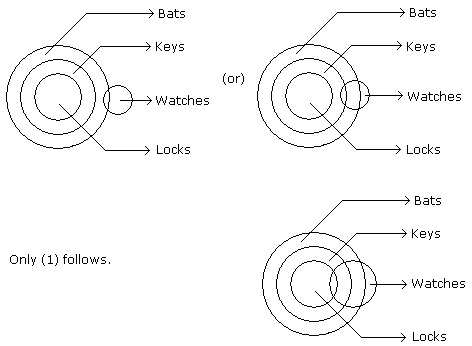Discussion
Home ‣ Verbal Reasoning ‣ Mathematical Operations See What Others Are Saying!
- Question
- If + mean x, - means + , ÷ means + , x means - then the value of 162 x 52 - 26 ÷ 15 + 5
Options- A. 247
- B. 235
- C. 875
- D. 215
- Correct Answer
- 235
Explanation162 - 52 ÷ 26 + 15 x 5
= 162 - 2 + 75 = 235 - 1. Find the odd one out:
Options- A. Mars
- B. Sun
- C. Saturn
- D. Mercury Discuss
- 2. Which one is true?
I. All players are not tall.
II. All basketball players are tall.
III. All tall people are players.
IV. Some players are tall.
Options- A. IV
- B. III.
- C. II.
- D. I. Discuss
- 3. 'Crawl' is related to which of the following in the same way as 'Fly' is related to 'Parrot'?
Options- A. Rabbit
- B. Fish
- C. Frog
- D. Crocodile Discuss
- 4. NA
Options- A. Mattress
- B. Pillow
- C. Bed sheet
- D. Curtain Discuss
- 5. Smoke : Pollution :: War :?
Options- A. Peace
- B. Victory
- C. Treaty
- D. Destruction Discuss
- 6. Statements: All the locks are keys. All the keys are bats. Some watches are bats.
Conclusions:
- Some bats are locks.
- Some watches are keys.
- All the keys are locks.
Options- A. Only (1) and (2)
- B. Only (1)
- C. Only (2)
- D. Only (1) and (3) Discuss
- 7. NA
Options- A. Tomato
- B. Potato
- C. Carrot
- D. Onion Discuss
- 8. 120, 99, 80, 63, 48,?
Options- A. 35
- B. 38
- C. 39
- D. 40 Discuss
- 9. 1, 1, 2, 6, 24,?, 720
Options- A. 100
- B. 104
- C. 108
- D. 120 Discuss
- 10. Lion : Cow : Land
Options- A. Water : Land : Air
- B. Whale : Hippopotamus : Water
- C. Chair : Table : Stool
- D. England : Germany : USA Discuss
More questions
Correct Answer: Sun
Explanation:
All are planets, except sun.
Correct Answer: II.
Explanation:
Statements 1 and 4 are more or less similar.
All tall people cannot be players.
So, Statement 2 seems to be true.
Correct Answer: Crocodile
Explanation:
'Parrot' flies and 'Crocodile' Crawls.
Correct Answer: Curtain
Explanation:
All except `curtian' are parts of bed-spread.
Correct Answer: Destruction
Explanation:
Second is result of the first.
Correct Answer: Only (1)
Explanation:

Correct Answer: Tomato
Explanation:
All others grow under soil.
Correct Answer: 35
Explanation:
The pattern is - 21, - 19, - 17, - 15,.....
So, missing term = 48 - 13 = 35.
Correct Answer: 120
Explanation:
The given series is the pattern x1, x2, x3, x4, .............
so, the missing term = 24 x 5 = 120
Correct Answer: Whale : Hippopotamus : Water
Explanation:
'Lion' and 'Cow' are 'land' animals and similarly 'Whale' and 'Hippopotamus' are 'Water' animals.
Comments
There are no comments.More in Verbal Reasoning:
Programming
Copyright ©CuriousTab. All rights reserved.
